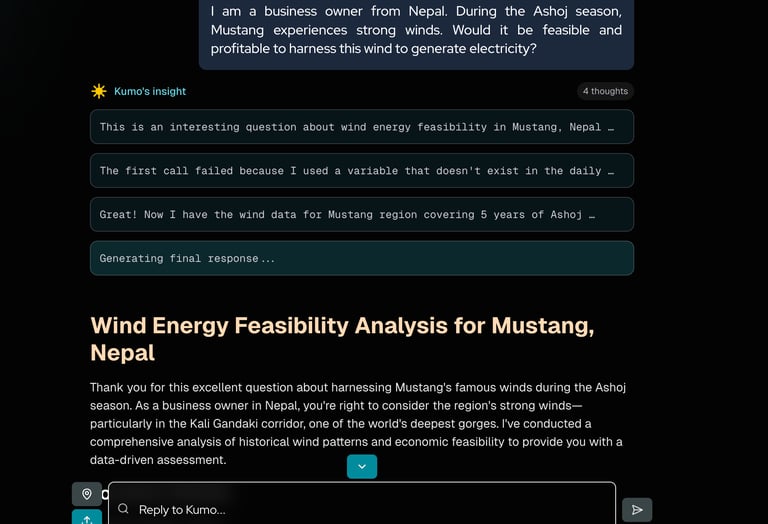Weather AI in Energy Trading: Turning Weather Volatility into Strategic Advantage
Weather AI is transforming modern energy trading by turning unpredictable weather-driven fluctuations into strategic advantage. By combining satellite data, IoT sensors, and machine learning, traders can forecast renewable output more accurately, reduce risk, and capture profitable opportunities in volatile markets.
11/7/20254 min read
When Weather Calls the Shots
Over the past decade, energy markets such as Japan, India, Europe have transformed faster than a lightning strike on a solar panel. The sudden powerful forward or upward movement in renewable energy (wind and solar) has slashed carbon emissions, but it has also introduced a mischievous new player: weather-driven market volatility.
Unlike coal or gas, which hum predictably in power plants, wind turbines sway and solar panels blink with the whims of clouds and gusts. Energy traders are no longer just reading price charts, they’ve become amateur meteorologists.
Imagine this:
A cloud suddenly drapes over Rajasthan, and gigawatts of solar power vanish in minutes.
Wind slows in Hokkaido, sending Japanese day-ahead electricity prices on a rollercoaster.
A cold front sweeps across Germany, sparking demand powerful movement that ripple through the European grid.
These shifts aren’t minor hiccups but they reshape prices, challenge grid stability, and squeeze profits. So, we can estimate according to the recent trends that
Energy markets are now weather markets.
To survive and thrive, traders need more than traditional forecasts, they need Weather AI, turning atmospheric chaos into strategic advantage.
Let’s preview some of the vulnerabilities in the recent energy markets.
1. The Core Problems in Today's Energy Markets
Problem 1: High Price Volatility – When Prices Go Wild
Markets dominated by renewables behave like teenagers on espresso, full of sudden energy spikes. Weather swings translate directly into supply fluctuations, which then send electricity prices on wild rollercoaster rides.
These are some empirical examples to have a better understanding:
Japan (JEPX): Hokkaido’s wind slows, and generation output drops by double digits within hours. Prices jump, traders sweat, and positions wobble.
India (IEX): Midday solar oversupply in Rajasthan or Gujarat can push electricity prices negative. Generators scramble to curtail output or face financial pain.
Europe (EPEX SPOT): North Sea wind fluctuations ripple across Germany, the Baltics, and Iberia, creating domino-like price effects.
Why it happens: Weather controls supply. Thermal plants? Predictable. Renewables? Entirely at the mercy of clouds, wind, and sun. Markets are now puppets of the atmosphere.
Problem 2: Forecasting Gaps – The Blind Spots
Traditional weather models weren’t designed to help traders. Therefore, they can miss critical short-term shifts that matter for energy markets.
Key Forecasting Limitations:
Clouds on the Move: NWP models (10–25 km resolution, hourly updates) can't see clouds zipping across solar panels in minutes.
Local Wind Turbulence: Micro-scale effects: terrain, thermal plumes, boundary layers. Create forecast errors at the exact spot of a turbine.
Temperature Swings Impact Demand: Slight temp changes trigger building heating/cooling responses, which conventional models often oversimplify.
So, whats an Impact?
Solar generation forecasts can be off by 20–30%. Imagine setting your day-ahead market position based on a 25% error margin, financially risky territory.
Problem 3: Balancing and Grid Stability – Walking the Tightrope
Grid operators must match supply and demand second by second. With renewables, that’s like juggling flaming torches in a windstorm.
Issue: Frequency instability
Impact: Risk of blackouts
Consequence: Grid deviations beyond ±0.2 Hz can disconnect generation, causing cascading outages
Issue: Curtailment
Impact: Wasted energy & revenue
Consequence: Excess renewable generation that cannot be stored is deliberately reduced
Issue: Balancing market penalties
Impact: Higher costs for generators & traders
Consequence: Deviations from scheduled positions result in steep financial penalties
If we look at the financial hit:
Penalties can consume 5–15% of renewable revenue. Add lost energy from curtailment—billions lost globally.
2. How Weather AI Changes the Game
From Guesswork to Weather-Savvy Trading
Weather AI is not your standard forecast. It blends satellite data, ground sensors, and machine learning into hyper-accurate predictions tailored for energy markets.
Core Components of Weather AI:
Satellite Remote Sensing: Tracks clouds, aerosols, land temperature, and moisture at high resolution.
Ground Sensor Networks: IoT weather stations, anemometers, and solar sensors provide hyperlocal validation.
Machine Learning Models: LSTM, CNN, Transformers uncover complex patterns linking weather to energy output.
Grid & Market Integration: Prices, transmission constraints, and demand patterns feed models, linking weather to real-world trading outcomes.
Paradigm Shift: No longer single-point predictions. Weather AI provides probabilistic forecasts, like:
"70% chance wind speed > 7 m/s; 30% chance > 10 m/s."
Traders now have confidence intervals, not just guesses.
AI-Enabled Capabilities
Capability: Short-term cloud/wind prediction
Time Horizon: Minutes–hours
Trading Benefit: Intraday trading signals
Operational Application: Adjust positions in real-time, manage imbalances
Capability: Medium-term generation forecasts
Time Horizon: 1–7 days
Trading Benefit: Accurate day-ahead bidding
Operational Application: Optimized market participation
Capability: Long-term climate trend analysis
Time Horizon: Weeks–months
Trading Benefit: Strategic hedging & contracts
Operational Application: Forward contracts, infrastructure planning
Competitive Advantage: Weather volatility is now quantifiable opportunity, not uncontrollable risk.
3. Real-World Examples & Case Studies
Let’s look at some real time examples to visualize our concepts more clearly. The examples are listed below along with impact and results:
Japan – High-Frequency IoT Trading
Implementation: Soratena Pro monitors seven weather parameters every minute: temperature, humidity, pressure, wind, precipitation, solar illuminance.
AI Integration: ML algorithms process IoT + satellite + NWP data to predict generation ramps minutes before they happen.
Results:
15–25% reduction in balancing market costs
Intraday arbitrage opportunities captured before competitors react
India – Solar & Storage Optimization
Context: Afternoon “duck curve” in Rajasthan/Gujarat. Solar drops, demand spikes.
AI Solution: Weather AI predicts decline timing & magnitude.
Storage Optimization:
Charge batteries during oversupply (low/negative prices)
Discharge during peak (high prices)
Impact:
25–40% higher arbitrage returns
Grid stabilization: less thermal ramping, improved reliability
Europe – Ensemble Forecasting Across Borders
Market Structure: Interconnected regions; North Sea wind affects Germany, Poland, Iberia, etc.
Challenge: Correlated weather events trigger simultaneous shortfalls.
Solution: Ensemble forecasting produces hundreds of scenarios with spatial correlation.
Trading Applications:
Identify correlation risk
Optimize cross-border positions
Hedge tail risk
Result: 12–18% higher risk-adjusted returns vs deterministic forecasts.
4. Strategic Outcomes – Turning Chaos into Profit
Outcome: Improved trading accuracy
Mechanism: Reduced forecast error
Quantifiable Impact: 15–25% P&L improvement
Outcome: Better renewable utilization
Mechanism: Reduce curtailment
Quantifiable Impact: 5–10% less wasted energy
Outcome: Reduced operational risk
Mechanism: Probabilistic forecasts
Quantifiable Impact: 20–30% lower balancing charges
Outcome: Stronger grid stability
Mechanism: Early warning of ramps
Quantifiable Impact: 33% fewer emergency grid activations
Key Insight: Weather AI doesn’t remove volatility—it turns it into opportunity.
5. The Future is Weather-Intelligent
Renewable penetration: 60–80% by 2040 in advanced economies.
Regulatory Evolution: Shorter settlement intervals, probabilistic bidding, dynamic reserve requirements.
Competitive Bifurcation:
Proactive Traders: Leverage Weather AI, gain first-mover advantages
Reactive Traders: Rely on conventional forecasts, face systematic disadvantages
Temporal Advantage: Minutes matter.
Weather AI gives informational lead time, translating directly into profitability.
Conclusion – Mastering Weather, Mastering Markets
Energy markets have evolved: weather now drives supply. Traders ignoring this reality will react too late.
Weather AI integrates satellite, IoT, ML, and probabilistic forecasting—turning uncertainty into strategic advantage.
Results from Japan, India, and Europe:
15–25% lower trading costs
25–40% higher storage arbitrage
12–18% improved risk-adjusted trading
20–30% lower balancing penalties
In a world where milliseconds matter and clouds control supply, the message is clear:
Weather AI is not the future—it’s the present.
Master the atmosphere, and you master energy trading.




